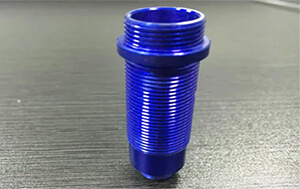Finishing Service
When it comes to your product, performance is vital — but the finishing touches can make all the difference. Expedited proudly offers an extensive selection of professional finishing services to supplement our manufacturing processes, giving you everything you need for a standout prototype or market-ready product. Additionally, for parts requiring specific surface characteristics or properties, we offer the following finishing options:
| Anodizing protects metal by increasing the thickness of its surface oxide layer. When a coating less than 0.001” is produced, it is called standard or Type II anodizing. When coatings thicker than 0.001” are produced, it is called hardcoat or Type III anodizing. Anodizing is often used to color parts, improve durability and enhance corrosion resistance. It also provides better adhesion of lubricants to raw metal and reduces galling of threaded components. Anodizing is typically applied to aluminum, but can also be applied to other metals and dyed to almost any color. |

|
| Anodizing |

|
The process of using
an electric current to reduce dissolved metal cations so that they form a
thin coherent metal coating on an electrode, to change the properties of the
metal surface or build up thickness for undersized parts. Chrome plating,
nickel plating and more are often applied at CNC LATHING.Due to how thin it is, plating does not substantially hide or smooth surface imperfections. Plating is commonly used to prevent corrosion, increase durability, alter surface friction, and improve appearance. |
| Plating (Electroplating) |
| Polishing, also known as buffing, a process of rubbing the surface of parts or utilizing a chemical action to produce a smooth and shiny surface, make the surface get significant specular reflection or reduce diffuse reflection in some materials.Due to the diameter of the buff wheel, typically about 6”, buff polishing may not be effective on parts that contain sharp, intricate, recessed, or fragile features.Note that harder materials like stainless steel take longer and are more costly to buff polish than softer materials like aluminum. |

|
| Polishing |
 |
Brushing is used to deburr and remove surface defects from sheet metal parts. The surface pattern created is a uniform parallel grain resulting from the brush moving against the workpiece in one direction. Brushed parts will have slightly rounded edges on sides not parallel to the brushing direction. |
| Brushing |
| Powder coating is a finishing process that bakes powdered plastic onto a statically charged metal surface. It looks similar to paint but is more durable. The coat is hard and abrasion-resistant.Generally,textures including Gloss, Matte, Texture and Metallic, and colors have Orange, Red, Purple, Pink, Green, Blue, Brown, Tan and Yellow.The main applications including household appliances, aluminum extrusions, drum hardware, automobile, motorcycle, and bicycle parts. |

|
| Powder Coating |

|
Black oxide, sometimes referred to as blackening, is a low-cost finishing method for adding corrosion resistance, reducing reflection, and enhancing the appearance of parts. Black oxide conversion coatings are created by submerging ferrous parts in a hot alkaline aqueous salt solution bath. Once immersed, a chemical reaction is created on the surface of the parts, which results in a magnetite coating. As a final step, an after-finish of oil, wax, or lacquer is applied for added corrosion resistance. |
| Black Oxide |
| A common chemical surface treatment method mostly for steel and stainless steel, to use a light coat of protective material to create a shell for enhancing the corrosion resistance or reducing the chemical reactivity. Passivation of stainless steel removes free ironand ferrous contaminants on metal surface with an acid solution to prevent rust. |

|
| Passivation |

|
The process through utilizing heating or chilling usually under extreme temperatures to make the metal achieve a certain state or change some characteristics, heat treating techniques including annealing, tempering, hardening, precipitation strengthening, tempering, carburizing, normalizing and quenching. |
| Heat Treatment |
| The process of spraying paint, pigment, or color to a solid surface as a colored protective layer, and can be done on metal or non-metal CNC machined components of any shapes, usually applied on aluminum, stainless steel and steel alloy parts. The purpose is to improve aesthetic appearance and prevent corrosion or oxidation. |
 |
|
Painting |
CATEGORIES
LATEST NEWS
CONTACT US
Contact: Jerry
Phone: +86 13812514404
Tel: +86 13812514404
Email: info@etmachining.com
Whatsapp: +86 13812514404
Add: No.7 Century Industrial Zone, Pinghu Street, Longgang District, Shenzhen China
- online service
- +86 13812514404
- info@etmachining.com
-
We chat
